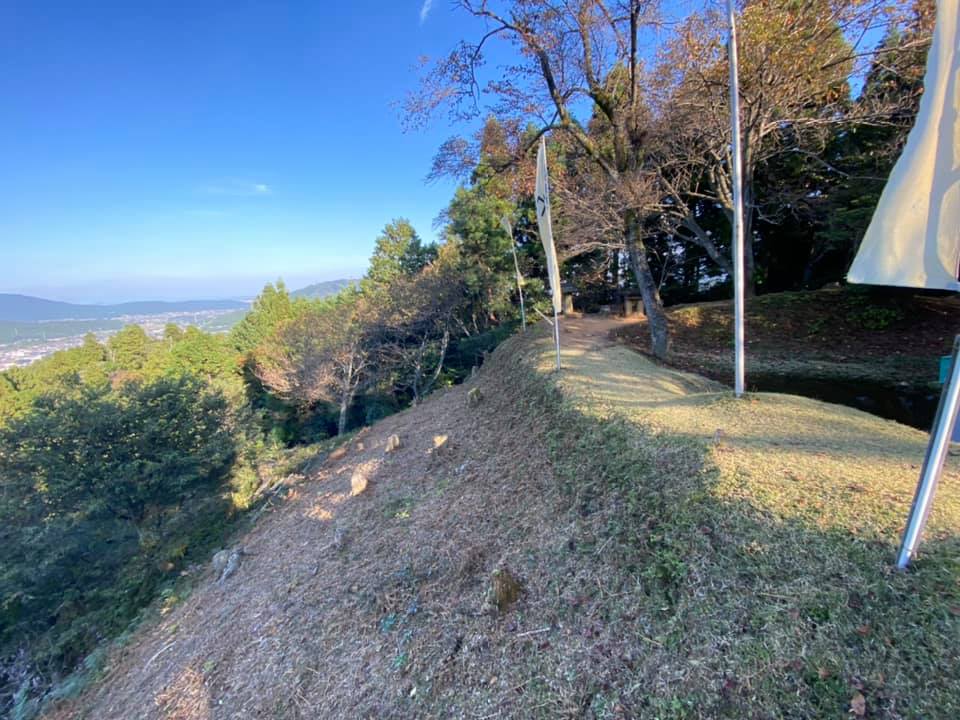History
Matsuoyama is a mountain in a strategic location at a narrow point between provincial borders and long hosted a fort. The ruins of castle we see today was the Matsuoyamajō built by Itō Morimasa under the orders of Ishida Mitsunari in the lead up to the battle of Sekiǵahara in 1600.
The first iteration of Matsuoyamajō was built, it is said, in the early 15th century by the Tomishima Clan. Thereafter, iterations of Matsuoyamajō include the fort built by Higuchi Naofusa under Azai Nagamasa in 1570, and, after the defeat of the Azai and the capture of that fort , a fort held by Fuwa Mitsuharu, a vassal of Oda Nobunaga, until 1575. Between then and 1600, Matsuoyamajō was abandoned.
In 1600, Itō Morimasa rebuilt Matsuoyamajō in anticipation of conflict between his liege, Ishida Mitsunari, and Tokugawa Ieyasu. Before the final battle began, however, Kobayakawa Hideaki chased Itō Morimasa from the castle, and used it as his own jinsho (battle camp) during the battle. The Western Army under Mitsunari strongly suspected that Hideaki would betray them and join the Eastern Army. Then the plot-twist that everybody saw coming happened when Hideaki charged Western Army positions beneath Matsuoyamajō. The rest, as they say, is history.
Visit Notes
Matsuoyamajō is a yamajiro (mountaintop castle) in Sekiǵahara Township, Fuwa County. Ruins include dorui (earthen ramparts), kuruwa (baileys), dobashi (earthen bridges), horikiri (trenches), tatebori (climbing trenches) and a smart left-facing masugata (square) gate complex in the main bailey. The main bailey is ensconed by dorui, and a pond has formed beneath a corner of the ramparts. The views are commanding from here.
According to Chris Glenn, author of 'The Battle of Sekigahara: The Greatest, Bloodiest, Most Decisive Samurai Battle Ever', and related works, Matsuoyamajō is the largest castle site by surface area in Gifu Prefecture. Chris was nice enough to take a small part of us on a tour of Sekiǵahara's environs and jinsho sites, but we ran out of time for Matsuoyamajō. I had wanted to return ever since.
The hike up to the ruins takes about forty minutes. The layout of the castle is complex, and multiple ridges and peaks were fortified, which even created a distinctive 'saddle bailey' in between two of the fortified peaks. Climbing from the north route one comes first to a northeastern ridge spur. This bailey complex has a narrower profile than most at the castle, and the ensconcing dorui gives the image of a warship made of earth. There is what could be a turret site overlooking a trench toward the rear of this bailey.
Continuing on from here one comes to a point just below the main bailey, and its earthen ramparts bear down on the visitor. I explore castles by the 'main bailey last' rule, so I struck off to the right. This side path goes past a tatebori and leads to the aforementioned saddle bailey. It has a dorui partition in its upper part, and in its lower part there is a reservoir with a pond.
The bailey parallel to the main bailey is up next, and it has an interesting pit surrounded by dorui. The dorui is nice but a bit overgrown. It seems there was also a sunken gate here to protect the bailey. Behind the bailey is a trench and terrace; the horikiri is actually spanned by a dobashi, making me think there was perhaps another entrance to the bailey from the rear. The southwestern bailey is next, and the trench between it and the previous bailey could swallow a house. The southwestern bailey is long and winding, and terminated in a trench complex which would deliver a sequential right-left-right attack to any enemy trying to ascend the ridge up here.
South of the main bailey there are two bailey complexes; the eastern and south. The eastern is much like the northeastern bailey in that it is long and surrounded by dorui, though it is a bit overgrown and difficult to appreciate. The southern bailey complex contains a shrine and dorui. It has terraced baileys beneath, and a trench complex to the rear.
Matsuoyamajō is an expansive yamajiro. It is well maintained and signposted. I can recommend a visit to anyone who is interested in Sengoku period history and doesn't mind a little bit of a climb.
Profile updated by ART (2024). Gallery photos kindly supplied by ChrisG.
| Castle Profile | |
|---|---|
| English Name | Matsuoyama Castle |
| Japanese Name | 松尾山城 |
| Alternate Names | Mino-Matsuojō |
| Founder | Tomishima Clan; Higuchi Naofusa; Itō Morimasa |
| Year Founded | c.1400; 1570; 1600 |
| Castle Type | Mountaintop |
| Castle Condition | Ruins only |
| Designations | Local Historic Site |
| Historical Period | Pre Edo Period |
| Artifacts | Dorui, Kuruwa, Horikiri, &c. |
| Features | trenches |
| Visitor Information | |
| Access | Sekigahara Station on the Tokaidō Main Line; 30min walk to hiking trail |
| Visitor Information | 24/7 free; mountain |
| Time Required | 80 minutes |
| Location | Sekigahara, Gifu Prefecture |
| Coordinates | 35° 20' 50.24" N, 136° 27' 15.52" E |
|
|
|
| Admin | |
| Added to Jcastle | 2022 |
| Contributor | ART |
| Admin Year Visited | Viewer Contributed |












Enable comment auto-refresher
ARTShogun
Permalink |
RaymondWDaimyo
Permalink |